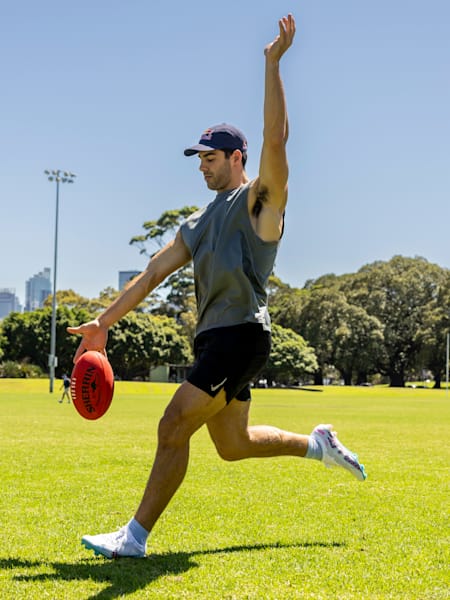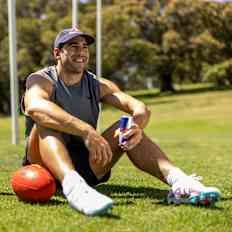Australian rules football (AFL) or more widely known as ‘footy’ is considered Australia’s national sport. There are approximately 1 million people playing the sport in Australia, with leagues starting to be introduced overseas. In 2023, it was reported that over 9.6 million people support one of the 18 AFL clubs and that number grows year on year!
The game was originally created in 1858 to keep cricketers fit during the winter months, however it has now become one of the most popular in the nation with kids learning to play from the age of five.
AFL is a unique game, played on an oval. The game is played at high speed and players have to be aware as other players can come from any direction. Players are highly skilled as they have to kick with both feet and use their fist’s to pass the ball in close quarters.
Each team has 18 players on the field, all playing different positions. Below we will explain what each one does and their responsibilities.
Backline
Back Pockets
There are two back pockets in each team. They position themselves deep in defence on the left and right side of the field. These players are usually quite agile and need to have good spoiling skills in the air. Highly rated back pockets are rated on their physicality and ability to win one on one contests in the air and on the ground. They usually play on the opposition's smaller, faster forward pockets.
When the ball turns over the back pockets generate forward momentum by using their elite kicking skills to find a mark up the field.
Full back
The full back is the ‘key’ defender in the backline. Positioning themselves as the last defender, and commonly manning the other teams full forward. A full back is normally larger in height and has a strong upper body as they are required to mark, spoil and keep the ball away from the other teams forwards.
A good full back must have a high defensive IQ and know how to position themselves to win the ball back for their team. When the ball is won they work together with the other defenders to work the ball out of the backline and start the attack.
Half Back Line
Half Back Flanks
There are two half back flankers in each team. Flankers play very similar roles to that of the back pockets. They play higher up the field on the left and right hand side of the ground. They need to have the same defensive IQ and skillset as the back pockets but they have more responsibility on offence when the ball turns over. Half backs are usually mid-sized players with high aerobic capacity as they need to be able to continually run up the ground in attacking plays and then run hard back to stop their opposing forward flanker.
The best half back flankers are known for their elite kicking skills and high speed running which allows for them to open up the game. They are usually players with no fear.
Centre Half Back
The centre half back has one of the most crucial roles on the field. Their role is typically to go one on one with the other team's best forward. Similar to the full back, they are usually tall, big bodied players who play with physicality. They need to be able to win crucial contests and support the other defenders.
Centre Half Backs are a great option to kick to from kick ins as they are a big, strong target. They can also take the kick ins on occasion as they can often cover 55m with their long kicks.
Centre
Wingers
A winger plays along the left/right side of the ground, most prominently in the middle areas.
Their job is to give their teammates a wide option and to be an attacking threat from the wide areas of the ground. A winger must require elite endurance, speed and skills as they are required to cover a large amount of the ground over the course of a game.
They must be very skillful in their attack but also may be required to run back and help the defenders to slow the opposition down. It is also crucial that the winger man the opposing winger, as they too can be just as dangerous with their team.
Midfielders
A midfielder is very important. They start every game or stop in play at the contest. Their first job is to win the ball from the ruck tap, then work the ball out to start an attack forward. Midfielders are commonly required to be at the contests where the footy is, but also hold a good position through the middle of the oval so they can be a part of their team's attack.
They are typically medium sized and require high speed, acceleration, power, quick thinking and elite skills. A midfielder does the most running out of anyone. Meaning they sometimes require a rest on the bench or a change to a less demanding position to regain their energy.
Red Bull athletes Christian Petracca and Travis Boak are 2 of the elite midfielders in the AFL and display extreme fitness, discipline and skill.
Ruck
The ruckman is the tallest player on the field. Their job is to win the ruck contest and tap the ball down to their midfielders. The ruck contest plays like a jump ball in basketball, however the 2 rucks are given a run up which adds importance to the players jumping and timing ability.
These ruck contests happen after a goal, at the start of a quarter, or after a stop in play anywhere around the ground.
The height of a ruckman can also be utilised to be a marking target for someone to kick to, as they can leap in the air and catch the ball with ease due to their height advantage.
Forwards
Half forward flanks
The half forward flanks play on both sides of a teams forward line on either side. They play a little bit higher than the other forwards and assist in the attack high up the ground. They can sometimes support the midfielders to win the ball if it is in their forward half but can also play inside the forward 50 to be an option to score and kick goals.
They have a defensive role too, if the other team is trying to work the ball out of defence, the forwards must defend and apply pressure to try and lock the ball in their forward half. This gives the team the best chance to score.
This type of player is small-medium sized and requires the same skills as a midfielder.
Centre half forward
The centre half forward is commonly the best forward in a team. Typically a team will play 2 tall forwards, the centre half forward is the quicker and more nimble of the 2 tall forwards. They provide their team with a tall option to kick to, and are required to win 1 on 1 marking contests against the defenders.
A centre half forward has height, strength and a strong skill set that allows them to be a goal scoring threat for their team.
Forward pocket
A forward pocket plays deep in the forward line and provides a scoring threat for their team. They are typically small in size but have an insane level of speed, skill, and agility. Bobby Hill is one of the best forward pockets in the league, he has incredible speed and uses his skills at ground level to get away from defenders and score goals. The forward pocket must also have a high IQ and be able to make quick decisions. If the tall forwards drop a mark or the defenders spoil it, a pocket must be there to rove the ball and win it back.
A forward pocket also has a job to defend as the forward flanker does. They apply pressure to lock the ball in and win it back close to goal.
Full forward
A full forward is the deepest target in a team and is responsible for kicking goals. They are very tall and must have a good marking ability. A full forward needs a strong upper body and goes 1 on 1 with the other teams full back. They aren't the most agile players but they have very good skill and knowledge to play their role.
Commonly a player who kicks the most goals is a full forward.
Conclusion
Every player on the ground has an important role to play. And when it all comes together it can be a joy to watch. AFL is a very demanding sport on athletes, and although there are different positions and traits, all players must require elite fitness, strength and skill.
Part of this story











